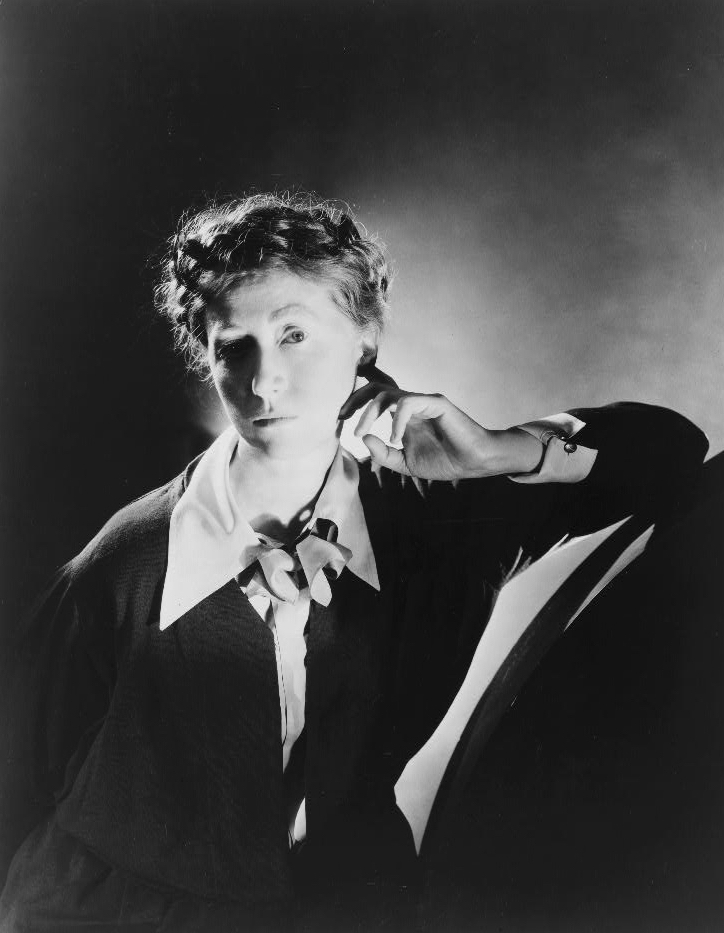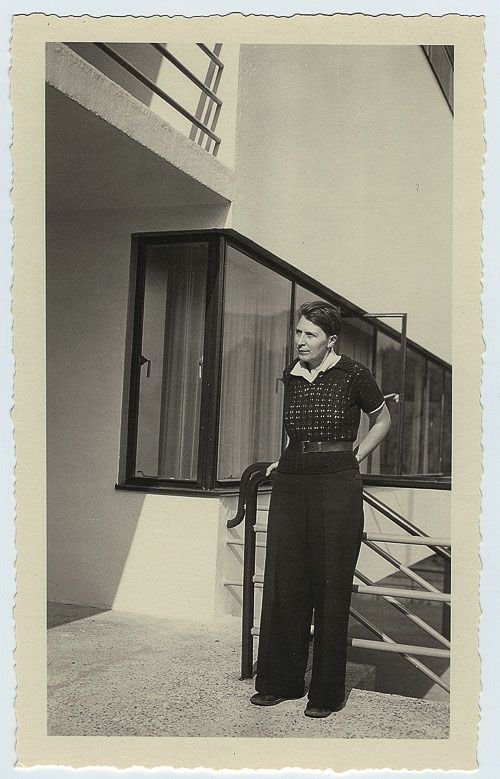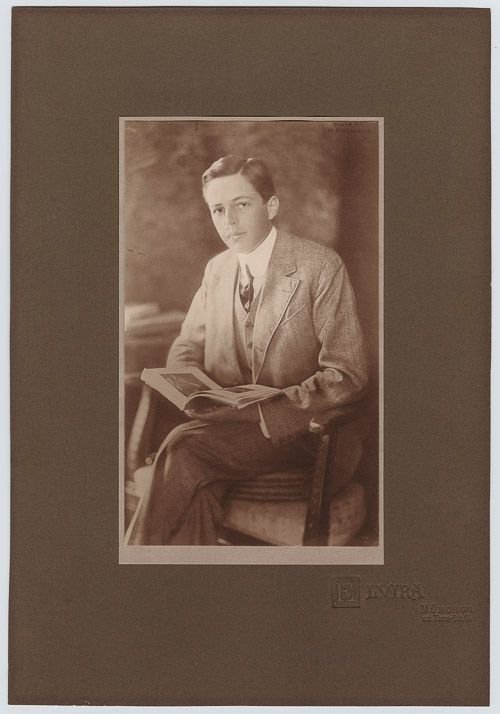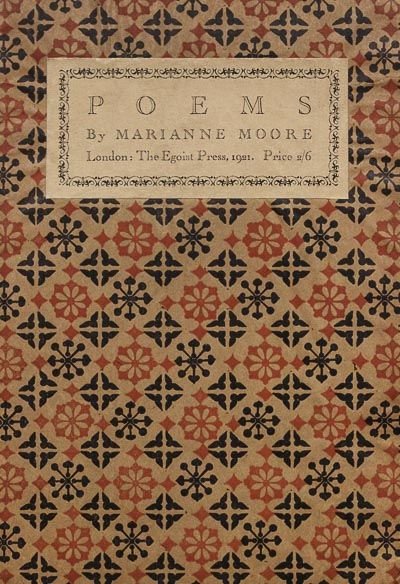“To fulfill a private obligation”: Marianne Moore, Her Patrons, and the Social Economy of the Gift
by Síofra McSherry
Published July 2017
Abstract
This paper focuses on material and financial gifts received by the American modernist poet Marianne Moore (1887-1972) under the auspices of patronage. Extrapolated from Moore’s letters, archival ephemera, and the work of her biographers, Moore’s main patronage relationships are analyzed as gift exchange cycles encompassing financial support, material gifts, and the writing produced by the poet. The reading draws from ethnographic literature on the gift economy in the tradition of Marcel Mauss, Claude Lévi-Strauss, and Lewis Hyde. After a brief outline of the role of the patron in the avant-garde circles of the early 1920s, Moore's interactions with several key benefactors are examined: Scofield Thayer, James Sibley Watson Jr., and Bryher. The paper aims to demonstrate first, how patronage may be considered a gift economy, outlining the effects and functions of such a system, and second, how such a reading may assist in the interpretation of patronage interactions.

Modernist, New Yorker, and resolutely unmarried, the American poet Marianne Moore relied heavily on the patronage of wealthy benefactors to sustain her life and writing. She accepted both material and financial gifts from patrons. These included Scofield Thayer and James Sibley Watson, who published, employed, and presented her with the Dial Award, and Bryher (the pen name of Winifred Ellerman), who gave her financial assistance and published her first book, Poems, without her knowledge. Drawing on ethnographic literature on the gift economy in the tradition of Marcel Mauss, Claude Lévi-Strauss, and Marilyn Strathern, this paper aims to demonstrate how viewing patronage relations as a gift economy may assist in the interpretation of Moore’s often subversive interactions with her patrons.
Lévi-Strauss summarized the concept of gift exchange as follows:
[Gift] exchange [. . .] permeates every transaction, ritual or profane, in which objects or produce are given or received. Implicitly or explicitly, the double assumption is found everywhere that reciprocal gifts constitute a means [. . .] of transferring goods, or certain goods, and that these gifts are not offered principally or essentially with the idea of receiving a profit or advantage of an economic nature. (53)
The ethnographic literature of the gift helps us unpack the dynamics of a monetary exchange that remains distinct from the market, and as such has proved attractive to thinkers attempting to define the paradoxical position of the artist within a capitalist economy as discussed by Lewis Hyde, Lee Konstantinou, and Elizabeth-Jane Burnett. While the visual arts retain a model of patronage that both mirrors and sustains the art market, in which the collector purchases artwork, no direct exchange of goods for money is made when a patron funds a writer. Hyde has explained this situation by positing that patronage is a gift made in return for the gift of an artist’s work. In this reading a patron’s support is not a wage or fee for service, but a gift given in recognition of the artist’s gifts, which Hyde somewhat problematically considers to be innate (Hyde 359). With patronage, as opposed to earned income in affiliated fields such as teaching, editing, or librarianship (all jobs accepted by Marianne Moore), the writer’s livelihood appears to exist within the gift-sphere in which the work is made, a sphere in which, as Lévi-Strauss put it, “these gifts are not offered principally or essentially with the idea of receiving a profit or advantage of an economic nature” (53).
Patronage in the 1920s Avant-Garde
The great patrons and collectors of modernist art and literature, such as Peggy Guggenheim and Harriet Shaw Weaver, were vital to the early stages of artist’s careers, establishing a market and venues for the avant-garde in addition to helping them pay the bills. The reach of wealthy patron-investors extended through the avant-garde circles of the Paris and New York, and the artists and writers they sponsored were drawn from those social networks. Guggenheim, for example, subsidized the lives of writers including Djuna Barnes, by allowing her to stay at her mansion in England
He designates patronage as one of several institutions that established and maintained these processes, an institution that had borne the brunt of commercialization and the new mass-markets for culture, morphing “what had once been an aristocracy of patron-saloniers” into “an elite of patron-investors” (43). The social network was partly defined by the patron, and, vice versa, the social network defined the patron’s supportive activities. This two-way process modulated the social space, with the cumulative effect of generating aesthetic cohesion. This parallels ethnographer Nancy Munn’s vision of a gift economy comprised of actions which themselves constitute the formal attributes of what she describes as intersubjective spacetime (Munn 9).
Patronage, however, is not necessarily a positive relationship, nor is it always a mutually beneficial one; the ambivalent cycle of generosity, indebtedness, and obligation that characterize the gift economy may be easily perceived within its dynamics. New York in the twenties was far from the hierarchical society of Renaissance Italy, and artists and writers enjoyed an unprecedented degree of authorship and control over their work.

However, the economic disparity between, for example, Marianne Moore, living in a single room in New York with her mother and Bryher, one of the wealthiest women of the age, was enormous. Djuna Barnes often complained of the control Guggenheim exerted over her social life and writing, expressing explicit concern that her gifts had not been freely given (Becnel 37). My thinking on this point owes much to Mary Ann Snyder-Körber’s interesting work in progress on Barnes and Guggenheim’s patronage relationship, which presents a nuanced perspective on the relationship between funding and form (Snyder-Körber 524).
Rainey has elsewhere blamed the sheltering effects of patronage for what he considered to be the weakness of H.D.’s poetry, in a reactionary argument challenging her rehabilitation into the canon. Bryher’s patronage, he argues, deprived H.D. of a robust readership and condemned her to the status of “a coterie poet, one whose writings circulated, like bonbons at a dinner party, among a cénacle of friends and hangers-on in wealthy bohemia” (Rainey, Institutions of Modernism, 148). Canonical male writers, including Pound and Eliot, also received patronage, and Rainey’s conclusion that financial support caused some poets (but not others) to remain “middling” is questionable. However, his input remains an interesting take on the burden patronage can be and suggests a reason why poets such as Moore might have been ambivalent about accepting it. Such generous giving, as Bourdieu points out, results in asymmetrical power relations, with one party very much at a disadvantage (216-17). Garber describes the historical stresses inherent in the relationship between patron and protégé, which had not dissipated by the 1920s:
This relationship often remained highly ambivalent: talent and money were equally eroticized, and some species of creative ingratitude was perhaps inevitable. The patronage relationships of modern authors were often further complicated by social and personal issues such as class, sex, and race, all of which exacerbated both the difference between patron and patronized and their mutual imbrication. (12)
The logic of the gift emerges in the terms Garber uses in her analysis: “creative ingratitude” and “mutual imbrication” both contribute to a “highly ambivalent” relationship. The patronage connection, like the gift, paradoxically both establishes a closer social bond—“mutual imbrication”—and increases the difference in status between the participants. Moore’s awareness of this disequilibrium is reflected in her numerous refusals or qualified acceptances of patronage. As in so many of Moore’s gift exchanges, her relations with her various patrons were ambivalent at best, forming a familiar pattern of refusals, breakdowns, and partial successes, of which some examples will be outlined below.
The Literary Sponsors: James Sibley Watson Jr. and Scofield Thayer
The Dial Award

Scofield Thayer was the immensely wealthy benefactor who bought The Dial magazine in 1919, and alongside James Sibley Watson Jr. transformed it into the famous modernist journal of the twenties that championed cummings, Joyce, Eliot, and Moore, among many others. Thayer and Watson ran The Dial at a large loss; the deficit for September 1922 alone was $9,000 (Ozieblo 500). Nevertheless they managed to pay their contributors, one of the few outlets for modernist writing to do so. Moore was selected as the recipient of the Dial Award in 1924, a financial prize specifically intended to be “no-strings-attached,” which T. S. Eliot received in 1922. Unlike the similar Guggenheim fellowships (est. 1925), it was awarded in reference to no particular project that must be completed, but rather to poets whose previous work was judged outstanding. It was “something given to afford the recipient an opportunity to do what he wished and out of that to enrich and develop his work”
Awarded at the pleasure of The Dial’s owners and with no requirement to make a return within a specified time frame, the Dial Award rests comfortably within the territory of the gift. Moore recognized this in the language of her response, stating that “never was a gift more complete and without victimizing involvements” (Joost 81; also see Moore, Selected Letters 216). She described Thayer and Watson’s work as patrons as “a non-exploiting helpfulness to art and the artist [. . .] the doctrine that ‘a love of letters knows no frontiers’”(Joost 81). In addition, Moore never spent her Dial Award money, but placed it into savings (Leavell 247-48).
Marriage
While Moore’s involvement with Watson, Thayer, and The Dial lasted until the late twenties, a more unconventional mode of patronage may have been extended to the poet from Thayer’s direction, in the form of a rumored proposal of marriage. Linda Leavell has linked a conversation in Thayer’s apartment on April 17, 1921 with a scene in Moore’s unpublished novel, in which a Thayer-like character offers marriage to the heroine, presenting her with “a pendant of square emeralds set in greenish gold filigree. Her favorite stone” (Leavell 189). In the manuscript, the protagonist refuses the gift and its implied obligations, stating, “I take and take and take, without sullying friendship with reciprocal givings. But I couldn’t take this” (189). We know that Moore refused any offer Thayer may have made—of marriage or mistresshood, as he was already married at the time.
Moore in fact never married, does not ever appear to have been romantically involved with anyone of any gender, and was resolutely chaste throughout her life. Leavell suggests that the proposal may not have been intended as a romantic union; rather “what he probably proposed was to make his fortune available to her, much as Bryher had married [Robert] McAlmon” (189). Just weeks before Thayer’s proposal, Winifred Ellerman, better known as Bryher, had entered into a marriage of convenience with the American poet in order to divert attention from her ongoing romantic relationship with Hilda Doolittle. Bryher recounts this episode with typical matter-of-factness, with no attempt to disguise the financial element of their arrangement:
I had happened to meet a young American writer, Robert McAlmon [. . . ]. He wanted to go to Paris to meet Joyce but lacked the passage money. I put my problem before him and suggested that if we married, my family would leave me alone. I would give him part of my allowance, he would join me for occasional visits to my parents, but otherwise we would live strictly separate lives. (Bryher 238-39)
This unexpected “earthquake,” as Moore described it, greatly upset her when she found out, and she freely expressed her dismay, telling Thayer “it was an outrage for anyone to marry Winifred Bryher in such style so unromantic” (Letters 152).
The economic or patronizing aspect of these proposals that so offended Moore illuminates the multi-faceted functionality of marriage within a gift economy as described in the literature on the gift. Marriage was notably analyzed in Lévi-Strauss’s The Elementary Structures of Kinship, in which the persons of women themselves were seen to form part of a gift economy envisioned as a structural whole that included property, wealth, and sustenance: “the exchange of brides is merely the conclusion to an uninterrupted process of reciprocal gifts” and marriage is made up of a “collection of reciprocal prestations” which are “sexual, economic, legal and social” (Lévi-Strauss 68, 66). That total condition represents a complete “mutual imbrication” in which the woman’s economic and social identity was completely altered by her marriage, with its lifelong financial commitment (Garber 12). In Moore’s view Bryher had submitted to an unequal exchange, or worse that she herself had become an exchange object. When Thayer’s alleged proposal occurred just a few weeks later, perhaps she most resented the suggestion that her writing might become part of a transfer of goods that included her own person.
Moore’s thoughts on the subject of matrimony during this period are clearly set out in her long poem “Marriage.” Leavell characterizes this “mock-epithalamium” as the most personal of all Moore’s poems (204), driven by her sense of betrayal by both Thayer and Bryher, by suggesting what she considered inappropriate unions with financial motivations. The betrothal emerald, as a symbol of the marriage transaction, appears glinting between lines that bustle with alarming monsters:
[. . .] Adam;
“something feline,
something colubrine”—how true!
a crouching mythological monster
in that Persian miniature of emerald mines
(The Poems of Marianne Moore 156)
The Persian miniature described contains a landscape inhabited by leopards, giraffes, and a monster. Only the mine—the genesis of the emerald—appears, not the finished and wearable jewel itself. The landscape with its crouching monsters and leopards is worrying and unsafe; to retrieve the jewel here might lead to a mauling and consumption by mythical beasts. It is unclear, however, whether the danger is greater for the suitor, who must navigate such a landscape to secure the engagement jewel, or for its recipient. The implicit threat in this image, however, soon emerges as a sense of horror threaded throughout the poem, with images of dismemberment and the breakdown of the body emerging unexpectedly:
the strange experience of beauty
its existence is too much;
it tears one to pieces
(156)
the spiked hand
that has an affection for one
and proves it to the bone,
(159)
He says, “These mummies
must be handled carefully—
‘the crumbs from a lion’s meal
a couple of shins and the bit of an ear’;
(160)
The repeated violence increases the stakes of the discourse and belies Moore’s attempts to downplay the political implications of the poem as “not an expression of my philosophy—merely a little anthology of phrases that I did not want to lose” (Rosenbach, Marianne Moore Newsletter 3.1 11). Her attitude toward the poem and its interpretation is as evasive as her stated approach to marriage itself, which she characterizes as an enterprise “requiring all one’s criminal ingenuity / to avoid!” (The Poems of Marianne Moore 155). Ellen Levy sees Moore setting up the expectation of a positive dialectic in the opening lines of the poem, an argument structured, like a marriage, to contain and unite opposites within a single frame. That expectation, she argues, is frustrated by the collaged and piecemeal construction of the remainder of the poem, a frustration she attributes to an Adornian embrace of negation, “the artist’s deliberate frustration of an expected aesthetic satisfaction”
Nor can the union of opposites, “opposed each to the other, not to unity,” take place when the participants are not equal in power and status, especially when there is a hierarchy in place within the institution itself (Moore, The Poems of Marianne Moore 162). Moore leaves no doubt about her conception of this hierarchy, writing, “experience attests / that men have power / and sometimes one is made to feel it” (160). Further, within the rubric of each gender’s complaints against the other, a female voice states, “‘Men are monopolists / of “stars, garters, buttons / and other shining baubles,’” (the quotation marks here are Moore’s) monopolizing, in other words, the exchange of property and power in which women, because they are component parts, cannot participate (160). Moore’s cynicism about the ritual of marriage itself, “public promises / of one’s intention / to fulfill a private obligation” is matched in the poem by her distaste for the requirements and restrictions of the married condition, particularly on women (155). Moore could not view marriage as an acceptable form of patronage, both avoiding it herself and expressing horror at Bryher’s decision to support McAlmon in this way. The obligations and restrictions outlined in “Marriage” sound very much like the sort of “victimizing involvements” Moore was thankful the Dial Award lacked (Joost 81).
The millionaire benefactor: Bryher
Bryher was herself a notable patron of Moore, offering her checks, gifts, and travel fares. Born in England in 1894, she was the daughter of one of the wealthiest men in England at the time. She took her pseudonym from an island in the Scilly Isles of the coast of Cornwall where she holidayed as a child, preferring a neutral-sounding name to represent her preferred masculine gender identity. A prolific author, Bryher produced many novels, memoirs, poetry, and critical works; today, however, she is remembered mostly as the romantic partner of the poet H.D. “and secondarily as a patron of experimental modernists” such as “James Joyce, Gertrude Stein, Norman Douglas, Edith Sitwell, Dorothy Richardson, Sylvia Beach, and Moore” (McCabe 608).
Bryher was an early and devoted admirer of Marianne Moore’s poetry. She first came to New York in September 1921 and entered Moore’s circle though H.D., who had known Moore at Bryn Mawr (Bryher 236-37). In many ways their exchange was mutual. Moore appeared in Bryher’s novel West (238) and offered her advice and encouragement on her writing (Moore, Letters 136). However, the heiress’s attempts to use her vast financial resources to help her friend tended to be disruptive to their relationship and were often unsuccessful.
The $5,000.00 elephant
Moore and Bryher quickly embarked on a correspondence that was frequent and intense, taking a fantastical and anthropomorphic turn. Bryher described her as a “pterodactyl stiffly watching from its Jurassic rock” and thereafter often addressed her letters to “Dactyl” (Leavell 182). The renaming game extended to the uncomfortable business of discussing money. In 1921, picking up on Moore’s admission of her love for elephants—to which she admitted she felt there pertained “an especial romance” (Letters 134)—Bryher offered the “price of a Burmese elephant” (Leavell 182) to Moore so she could quit her work at the library and write a novel; the offer of $5,000 was couched in a shared fantastical language of extinct and exotic beasts:
H.D. has reminded her [Bryher] that one cannot go on an adventure without gold, and that elephants cost about $5000.00 as she knows for her father has some in connection with a rice mill in Burma, and that the amount for an expedition shall be “extended on the point of a sword” if I will be a “good pterodactyl that will come out of its rock” and write a novel. (Letters 141)
Bryher attempted to use the personal language born of their burgeoning intimacy as a justification for her offer, as if she were a family member, in order to counter Moore’s reluctance. The poet refused the offer, however, despite H.D. writing to allay her fears, to apologize for the presumption of the gift, and to explain that Bryher’s father often sent sums to fund such projects (Leavell 182). Moore replied that she “couldn’t write a novel” and worked at the library “as much from choice as from necessity” (Letters 141). Her supposed inability to produce the expected novel is given as the main reason for her rejection of the gift, explaining to Bryher that she would not be able to undertake such a project for some years (Letters 141-42). Bryher was finally able to get a much smaller, three hundred dollar check to Moore only by forwarding it to her mother Mary, who promptly invested it in Pittsburgh along with Marianne’s Dial Award.
Poems

Bryher’s approach to patronizing Moore quickly evolved from her clumsy efforts to hand the poet a check. In June 1921, Moore received a copy of a book of her own poems, entitled Poems and published in England at the instigation of Bryher, H.D., and McAlmon without her knowledge or consent. This unwanted gift caused Moore a great deal of consternation: she had refused The Egoist’s offer to publish a volume a few months before and had stated that she considered it disadvantageous to publish at that time. Her acute discomfort at her lack of control over the volume’s editing and appearance is clear in her letters dealing with the subject:
Several poems could have been put in that aren’t in—many should be left out that are in and I would make changes in half the poems that are in but as B. wrote me if anything is not right “it is my own fault” for refusing to publish a book—and said if I liked I could prosecute The Egoist with the $300 she gave me. (Letters 170)
There is a clear sense that Bryher felt ownership over the work she had helped to sponsor and felt qualified to override the wishes of its author in disseminating it. If Moore claimed she would refuse to accept support on the basis of her social relationship with Bryher, her patron would directly support and publish the poetry itself without reference to the poet at all. The issue of Poems was another subject that dwelt with Moore for many decades. When she brought it up in a 1961 interview, she expressed gratitude but retained her sense that her patron had overreached. It must be emphasized that this action by Bryher was tantamount to robbery of the poet’s autonomy. Susan McCabe has described it as an “unwanted ravishment” (612).
“Aesthetic-Erotic Collaboration”
Moore often expressed concern at the scale of Bryher’s giving to friends and writers she admired. McCabe has undertaken a psychoanalytical examination of Bryher and Moore’s relationship:
Her “accidental” gender, her own illegitimacy, and great wealth, among other factors, kept her giving endlessly, fuelling (sic) what I elsewhere refer to as “the melancholy of money,” and what Moore called her “suicidal generosity,” suggesting her need to compensate and substitute for an ongoing sense of loss. (McCabe 609).
McCabe here suggests that Bryher’s constant desire to give was a result of attachment failures in her emotional life and reflected a need to compensate for these by establishing new bonds. Reading Bryher’s “endless” offerings through the theory of the gift complements this analysis. The gift establishes social bonds facilitating—or obligating—connection. The same obligations Moore considered to be “victimizing involvements” were sought out and initiated by Bryher through her continuous efforts at patronage (Joost 81).
Despite Moore’s lifelong celibacy, McCabe has characterized her interaction with Bryher as a “complex and ignored erotic friendship and collaboration,” suggesting that their relationship had an unacknowledged homoerotic aspect (McCabe 607). The additional element of emotional and sexual imbrication mirrors the complexities that Thayer’s presumed proposal of marriage introduced to his relationship with Moore and recalls Garber’s statement that patronage in the modern era “often remained highly ambivalent” because “talent and money were equally eroticized” and that patronage exacerbated not only bonds but unequal power relationships between participants (12). The eroticization of the dynamic is literal and analogous, as the participants’ relative positions within the gift economy of patron and patronized encouraged the formation of a social bond transcending the economic implications of the exchange. Hyde has adapted the concept of eros as an analogy for the responsive and cohesive spirit of the gift. The gift has the capacity for social and material imbrication, the contrary impulse to commercial or logos exchange:
A gift, when it moves across the boundary [between exchange participants], either stops being a gift or else abolishes the boundary [. . .] Logos-trade draws the boundary, eros-trade erases it. (Hyde 78)
The gift’s erotic dual function of boundary-breaking and bond-making is unsurprising within the context of a Maussian “total system” comprised of a “collection of reciprocal prestations” that include the social, legal, and sexual bonds of marriage and the persons of women (Lévi-Strauss 66). This is not to suggest that all gift exchanges bear or inevitably lead to the multivalent involvements of a marriage bond but rather, that all gifts manifest the potential for the generation of intimacy, including the erotic. The realization of this inevitability may help explain Moore’s often pedantic caution regarding what patronage she would accept and from whom.
Conclusion
The network of patronage that surrounded Marianne Moore and many of her contemporaries may be defined as a gift economy. Individual transactions are conducted as gift exchanges, and the interpersonal connections they create establish the socially modulated space of modernism. The often-strained bonds of obligation and reciprocation created by the gift provide a means of analyzing the poet’s defensive postures, estranged positions, and ambiguous exchanges with her patrons. While they both provided significant financial support over a period of years, both Thayer and Bryher occasionally offered patronage in ways which Moore could or would not accept, opting out of the exchange altogether to preserve her personal and literary autonomy. In 1921, Bryher and H.D. took “control” and ownership of the work they had patronized. Her traversal of the social space of the gift economy, with its permeability and potential for disruption, allowed Moore to simultaneously negotiate the gendered social and institutional implications of patronage, and manage the terms on which she accepted it.
Works Cited
Becnel, Kim. The Rise of Corporate Publishing and Its Effects on Authorship in Early Twentieth Century America. Routledge, 2012.
Bourdieu, Pierre. “Selections from The Logic of Practice.” The Logic of the Gift: Toward and Ethic of Generosity, edited by Alan D. Schrift, 1997, pp. 190-230.
Bryher. The Heart to Artemis. Paris Press, 2006.
Burnett, Elizabeth-Jane. “‘The Poetic Economy’: Investigating Possibilities of No Return.” How 2, vol. 3, no. 3, 2007.
Garber, Marjorie. Patronizing the Arts. Princeton UP, 2009.
Goldstone, Andrew. Fictions of Autonomy: Modernism from Wilde to de Man. Oxford UP, 2013.
Hall, Donald and Moore, Marianne. “Marianne Moore, The Art of Poetry No. 4.” Paris Review, Summer/Fall 1961, www.theparisreview.org/interviews/4637/the-art-of-poetry-no-4-marianne-moore.
Hoy, Cyrus and Marianne Moore. “University of Rochester Library Bulletin.” University of Rochester Library Bulletin: Marianne Moore, Letters to Hildegarde Watson (1933-1964), vol. 29, no. 2, Summer 1976, rbscp.lib.rochester.edu/3572.
Hyde, Lewis. The Gift: Creativity and the Artist in the Modern World. Vintage, 2007.
Joost, Nicholas. Scofield Thayer and The Dial: An Illustrated History. Southern Illinois UP, 1964.
Konstantinou, Lee. “Lewis Hyde’s Double Economy.” ASAP Journal, vol. 1, no. 1, Jan. 2016, pp. 123-149.
Kramer, Hilton. “Peggy Guggenheim as History.” 1986. The New Criterion, 6 June 2016, www.newcriterion.com/articles.cfm/Peggy-Guggenheim-as-history-6686.
Leavell, Linda. Holding on Upside Down: The Life and Work of Marianne Moore. Farrar, Straus and Giroux, 2013.
Lévi-Strauss, Claude. The Elementary Structures of Kinship. Translated by James Harle Bell, edited by Rodney Needham, Beacon Press, 1969.
Levy, Ellen. Criminal Ingenuity: Moore, Cornell, Ashbury, and the Struggle Between the Arts. Oxford UP, 2011.
McCabe, Susan. “‘Let’s Be Alone Together’: Bryher’s and Marianne Moore’s Aesthetic-Erotic Collaboration.” Modernism/Modernity, vol. 17, no. 3, 2010, pp. 607-637.
Moore, Marianne. “Marianne Craig Moore Papers M98.” Watson Collection, Bryn Mawr College Special Collections
---. Poems. Edited by Hilda Doolittle and Robert McAlmon, Egoist Press, 1921.
---. The Poems of Marianne Moore. Edited by Grace Schulman, Viking, 2003.
---. The Selected Letters of Marianne Moore. Edited by Bonnie Costello, Celeste Goodridge, and Christiane Miller, Faber and Faber, 1998.
Munn, Nancy D. The Fame of Gawa: A Symbolic Study of Value Transformation in a Massim Society. Duke UP, 1992.
Ozieblo, Barbara. “Alyse Gregory, Scofield Thayer, and the Dial Twentieth Century Literature.” Twentieth Century Literature, vol. 48, no. 4, 2002, pp. 487-507.
Povinelli, Elizabeth A. “Routes/Worlds.” E-Flux Journal, e-flux.com, no. 27, September 2011.
Rainey, Lawrence S. “Chapter 2: The Cultural Economy of Modernism.” The Cambridge Companion to Modernism. edited by Michael H. Levenson, Cambridge UP, 1999, pp. 33-68.
---. Institutions of Modernism: Literary Elites and Public Culture. Yale UP, 1998.
Snyder-Körber, Mary Ann. Modernism in American Centuries: Henry James, T.S. Eliot, Djuna Barnes, James Baldwin. 2014, Berlin. Unpublished manuscript.
Strathern, Marilyn. The Gender of the Gift. U of California P, 1988.
Watson, James Sibley. “Announcement.” The Dial, July 1929, p. 633.
Willis, Patricia C., editor. Marianne Moore Newsletter. Vol. 3, no. 1, Spring 1979.
Figures
Figure 1. Lynes, George Platt. “Marianne Moore (1887-1972).” Prints & Photographs Online Catalog, Library of Congress, www.loc.gov/pictures/item/90714780.
Figure 2. “Bryher (1894-1983).” Bryher Papers, General Collection, Beinecke Rare Book and Manuscript Library, Yale University, New Haven.
Figure 3. “Scofield Thayer (1889-1982).” Dial/Scofield Thayer Papers, Yale Collection of American Literature, Beinecke Rare Book and Manuscript Library, Yale University, New Haven.
Figure 4. “Cover of Poems, The Egoist Press, 1921.” Courtesy of the Watkinson Library at Trinity College, Hartford, CT.

